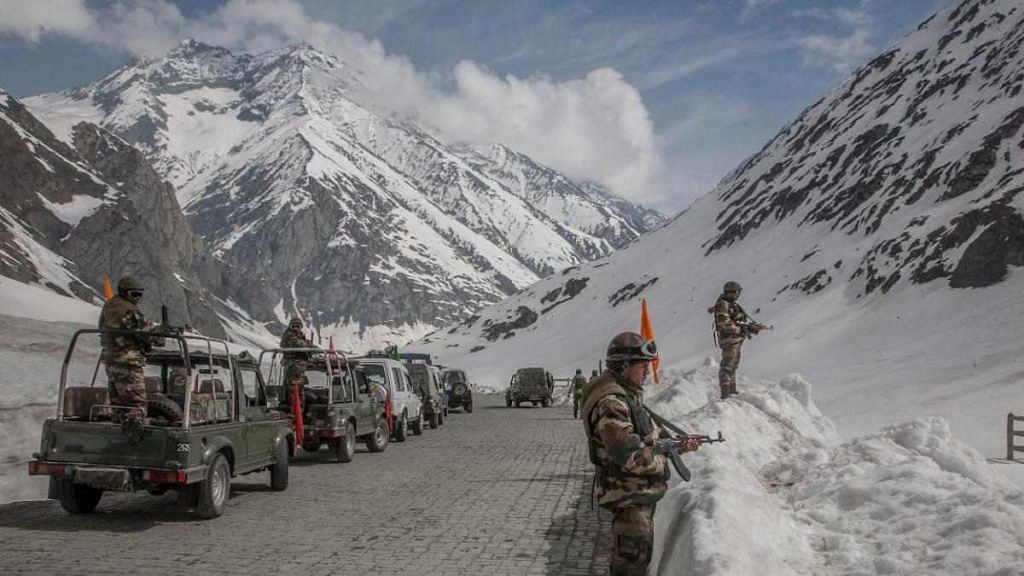New Delhi: India and China will hold the 12th round of Corps Commander level talks Saturday with an eye on possible disengagement in the Gogra and Hot Springs area of eastern Ladakh.
The talks, to be held in Moldo on the Chinese side of the Line of Actual Control (LAC), will begin at 10.30 am, according to sources in the defence establishment.
With this round, there is expected to be some progress in the disengagement process in Gogra and Hot Springs, which have been described as “low-hanging fruits” by sources.
However, they added, the other two friction points — Depsang Plains and Demchok — will take time.
This round of talks come at a time when China and India have continued massive deployment, of men and equipment, along the LAC besides development of infrastructure.
While China had initially proposed 26 July as the date of the talks, India disagreed with it since it was Kargil Vijay Diwas.
Also read: No consensus yet on structure of theatre commands, discussions, tweaks to continue
Both sides agreed to disengagement in Gogra, Hot Springs in 2020
Following the disengagement along the southern and northern banks of Pangong Tso in February this year, there has been no further progress at other standoff sites even though both sides had agreed to disengage in Gogra and Hot Springs last year.
While China did carry out some disengagement in the two areas, the process was not completed.
During the 11th Corps Commander-level talks in April, China had demanded de-escalation or withdrawing of additional troops that were brought in as backup by the two armies first.
This was a shift in China’s position from the discussions between the two sides in February.
India, however, has insisted on disengagement from remaining friction areas before de-escalation.
The Chinese intrusion in Gogra took place in May last year, after the People’s Liberation Army (PLA) violated the LAC at Pangong Tso leading to the first big clash between the two sides on 18 May 2020.
Sources explained that Indians used to patrol up to Patrolling Point-15 in Gogra, which is known as the Gogra Post.
However, in late May last year, a platoon from the PLA intruded about 3 kilometres inside the Indian perception of the LAC.
These soldiers were supported by a larger contingent of soldiers, who stayed put near the LAC.
The Indian side retaliated with “mirror deployment”, where they matched the PLA’s strength and pitched tents facing theirs.
Following the disengagement agreement, which was reached in the wake of the 15 June 2020 clash in the Galwan valley, the PLA was asked to move back.
However, while the Chinese did a limited pullback, they continued to maintain a small section of troops within the Indian territory.
Similarly, the Chinese intruded into the Indian territory of the larger Hot Springs area blocking PP-17 and PP-17A in late May 2020.
The Chinese had agreed to pull back from this area as well last year, but again did not implement the agreement completely.
Also read: China in focus, Army’s Strike Corps units reach Ladakh as part of ‘rebalance’ strategy
Depsang Plains and Demchok are legacy issues
Sources noted that resolution in Depsang Plains, which comes under Sub-Sector North, and the Demchok will take time.
As reported last year by ThePrint, tensions at Depsang Plains can be traced to 2013, when the PLA carried out an 18-km incursion into the area, which is close to the strategic Daulat Beg Oldi base.
Sources have said China has been blocking Indian patrol parties from accessing five patrolling points — 10, 11, 11A, 12 and 13.
They explained that Indian troops walk through an area, referred to as “bottleneck” as it is too narrow for vehicles, to reach these patrolling points.
Less than a kilometre after this is an area called ‘Y’ junction, which has two routes — one going to PP 10, 11, 11A and 12 and the other directly to PP 13.
Sources said the Chinese have set up cameras in this area and they end up blocking Indian patrols with the vehicles that they drive in from their side.
Unlike the Depsang Plains, Demchok has always seen face-offs and actual incursions.
In the past, the Chinese have objected to Indian herders accessing local grasslands, claiming it was their territory.
They have also built permanent facilities for soldiers in areas that India claims as its own.
Following fresh round of tensions in Ladakh last year, the Chinese carried out what was described as “minor transgression” in Demchok and the PLA also set up a “few” tents in the region.
Also read: LoC, cameras, action — how hi-tech equipment is helping Indian Army guard the border better
